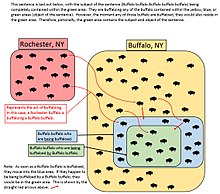Decoding The "Buffalo Buffalo" Sentence: A Linguistic Rollercoaster
Prepare to have your mind bent, your understanding of English stretched, and your perception of grammar challenged. Imagine a sentence made up of the same word, repeated eight times. Sounds like nonsense, right? Well, what if I told you that "Buffalo buffalo Buffalo buffalo buffalo buffalo Buffalo buffalo" is not only a real sentence but also grammatically correct and has a perfectly logical meaning? Yes, you read that right. This linguistic marvel is a famous example often used to demonstrate the incredible flexibility and occasional trickiness of the English language, particularly concerning homonyms and homophones.
For many, encountering this string of identical words is akin to solving a complex riddle. It sounds like a tongue twister designed to confuse, a nonsensical chant that could belong to a nursery rhyme. Yet, beneath its bewildering surface lies a perfectly structured and meaningful statement. Let's embark on a journey to unlock the mystery of this seemingly absurd, yet utterly brilliant, sentence.
Unpacking the "Buffalo"
The key to understanding "Buffalo buffalo Buffalo buffalo buffalo buffalo Buffalo buffalo" lies in recognizing that the word "buffalo" isn't just one word; it's three distinct parts of speech, each playing a crucial role in the sentence's construction.
Three Meanings, One Word
Before we dissect the sentence, let's clarify the multiple identities of "buffalo":
- "Buffalo" (capitalized): This refers to the city of Buffalo, New York. When used in this context, it often implies something or someone *from* Buffalo. So, "Buffalo buffalo" can mean "bison from Buffalo."
- "buffalo" (lowercase, noun): This is the common noun for the animal, the American bison. Interestingly, "buffalo" serves as both the singular and plural form for the animal, much like "fish" or "sheep."
- "buffalo" (lowercase, verb): This is perhaps the most surprising meaning for many. As a verb, "buffalo" means "to bully, confuse, deceive, or intimidate." Think of it as "to overpower" or "to baffle."
With these three definitions in hand, the seemingly chaotic sequence of words begins to take shape. It's like having three different tools that all look the same but perform unique functions.
The Grammatical Breakdown
Now, let's break down the full sentence, word by word, and see how these three meanings interlock to form a coherent statement. The sentence, "Buffalo buffalo Buffalo buffalo buffalo buffalo Buffalo buffalo," can be parsed as follows:
- Buffalo (1) buffalo (2): This is our first noun phrase. The capitalized "Buffalo" acts as an adjective modifying the noun "buffalo." So, this means "bison from Buffalo" or "Buffalo bison." (Subject of the main clause)
- Buffalo (3) buffalo (4): This is our second noun phrase, identical in meaning to the first: "bison from Buffalo." (Subject of the relative clause)
- buffalo (5): This is our first verb. It means "to bully." This verb is applied to the second noun phrase. So, "bison from Buffalo who bully..."
- buffalo (6): This is our second verb, also meaning "to bully." This verb is applied to the first noun phrase.
- Buffalo (7) buffalo (8): This is our third noun phrase, again meaning "bison from Buffalo." (Object of the main clause)
Putting it all together, the sentence translates to something like: "Bison from Buffalo [that] bison from Buffalo bully, bully bison from Buffalo."
To make it even clearer, let's add some implied words and punctuation, as suggested by some linguists:
"Buffalo buffalo, (that) Buffalo buffalo buffalo, buffalo Buffalo buffalo."
This more accurate sentence would translate to: "Bison from the city, that are bullied by bison from the city, bully bison from the city." It describes a scenario where a group of bison from Buffalo are bullied by another group of bison from Buffalo, and this first group, in turn, bullies yet another group of bison from Buffalo. It's a chain of bullying within the Buffalo bison community!
Why Does This Sentence Matter?
Beyond being a fascinating linguistic puzzle, "Buffalo buffalo Buffalo buffalo buffalo buffalo Buffalo buffalo" holds significant importance in the study of language. It's not just a clever trick; it's a profound demonstration of how English grammar works, how context shapes meaning, and how our brains process complex linguistic structures.
A Linguistic Landmark
This sentence is widely recognized as the most famous example of a homonym creating its own complete, grammatically correct sentence. It highlights the concept of homonyms (words that are spelled and sound the same but have different meanings) and homophones (words that sound the same but have different meanings or spellings). The sentence challenges our intuitive understanding of language, forcing us to look beyond the surface and delve into the underlying grammatical rules.
It's a testament to the fact that English, despite its many irregularities, operates on a logical framework. The sentence functions because each "buffalo" occupies a specific grammatical slot – subject, verb, or object – and its particular meaning is derived from that position within the sentence structure. It's a perfect illustration of how word order and context are paramount in conveying meaning in English.
A Historical Note
The sentence gained significant prominence when it was cited by Steven Pinker in his influential 1994 book, The Language Instinct. Pinker used it as an example of a grammatically correct but semantically challenging sentence that showcases the intricacies of human language processing. According to William Rappaport, a linguistics professor at the State University of New York at Buffalo (fittingly!), the sentence has been a subject of theoretical discussion for decades, exploring the limits of linguistic structures.
The enduring popularity of this sentence among linguists and language enthusiasts alike underscores its power as a teaching tool. It's a playful yet profound way to explore the depths of English syntax and semantics, proving that even the most repetitive string of words can hold a hidden, perfectly logical meaning.
The Takeaway
So, the next time you hear someone utter the seemingly nonsensical phrase "Buffalo buffalo Buffalo buffalo buffalo buffalo Buffalo buffalo," you'll be armed with the knowledge to decode its true meaning. It's not just a random collection of words; it's a perfectly structured sentence describing a specific interaction among bison from Buffalo, New York, where some are bullied by others, and those bullied ones, in turn, bully still others.
This sentence serves as a powerful reminder of the richness and complexity of the English language. It teaches us to look beyond the obvious, to consider multiple meanings, and to appreciate the subtle dance between words, grammar, and context that allows us to communicate such intricate ideas. It's a linguistic riddle solved, a testament to the surprising logic hidden within seemingly illogical expressions.
In essence, "Buffalo buffalo Buffalo buffalo buffalo buffalo Buffalo buffalo" is a masterpiece of linguistic economy, demonstrating that a single word, through its multiple identities and strategic placement, can construct a complete, meaningful narrative. It's a fascinating example of how language, at its core, is a system of rules that, when understood, can unlock even the most bewildering of phrases.

Buffalo buffalo Buffalo buffalo buffalo buffalo Buffalo buffalo: Let’s

Buffalo buffalo Buffalo buffalo buffalo buffalo Buffalo buffalo - Wikipedia

Buffalo buffalo Buffalo buffalo buffalo buffalo Buffalo buffalo – Wikipedie